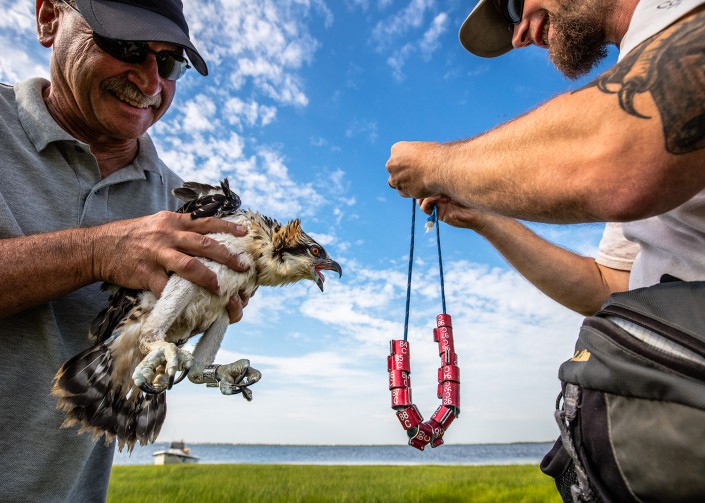Humans Help New Jersey Osprey Population Exceed 600 Nesting Pairs
2015 New Jersey Osprey Report documents close to 600 pairs up from low of 50 pairs
by Lindsay McNamara, Communications Manager

Today, we released the 2015 New Jersey Osprey Report with our partner New Jersey Division of Fish and Wildlife’s Endangered and Nongame Species Program (ENSP). The report highlights the continued recovery of this threatened bird of prey.
“Ospreys are an important indicator of the health of our coastal ecosystems, so it is important to track the health of their population. Their continuing recovery is a very promising sign for our estuaries and the fish and other wildlife that depend on clean water to survive” stated Conserve Wildlife Foundation executive director David Wheeler. “Today, no visit to a coastal waterfront would be the same without the magnificent sighting of an osprey soaring above or crashing down to the water’s surface for a fish.”
Though only about 50 osprey pairs remained in New Jersey in the early 1970s, the report documents close to 600 pairs using a total of 534 active nests in 2015, more than any other year in the project’s history.
CWF and ENSP survey an estimated 80% of the population and create an accurate representation of overall health. Biologists have come to rely on the assistance of specially trained volunteers (osprey banders) and many “Osprey Watchers” who report nests on Osprey-Watch.org.
“The vital work of our volunteers helps us keep our finger on the pulse of the population,” said Kathy Clark, supervising biologist with the DEP’s Endangered and Nongame Species Program. “Having dedicated volunteers is a great long-term monitoring tool and really strengthens the team’s ability to cover the state osprey population effectively.”
“Over the past few years we’ve really seen a shift in how we can track the overall health of the osprey population. In previous years, the use of aerial helicopter surveys to document the size and health of the statewide population allowed biologists to reach large areas, but was also very expensive,” stated Conserve Wildlife Foundation habitat program manager Ben Wurst. “Today, we utilize volunteers to help collect much of this valuable data. These ‘Osprey Watchers’ can view all nests, report nest activity, and other data online that we can, in turn, use to track the statewide population. The use of Osprey-watch.org also helps to raise awareness and educate citizens about ospreys and current environmental issues that aquatic ecosystems face today, including global climate change, depletion of fish stocks, and environmental contaminants.”
As in previous years, biologists and dedicated volunteers conducted ground surveys in mid-summer. These surveys were conducted in the most densely populated colonies of nesting ospreys in New Jersey. From the Meadowlands, south to Cape May, and west along Delaware Bay, a sample of each major colony is checked and nest outcome data are used to determine how well our ospreys are faring. During these surveys, the health of nestlings is assessed and they are banded with USGS bird bands for future tracking. Since this is usually the only visit to nests each year, the condition of the nesting platform is also noted and repairs or replacement are scheduled for the non-breeding season.
In 2015, CWF continued to band young ospreys produced in Barnegat Bay with a red, alpha-numeric coded auxiliary band. Project RedBand is focused on ospreys that nest in the Barnegat Bay watershed from Point Pleasant to Little Egg Harbor. The main goal of the project is to engage the public in osprey management and conservation along the Jersey Shore. At the same time, while collecting data from re-sightings, biologists will learn about their dispersal, foraging habits, site fidelity, migration routes, and life span. This year 33 bands were deployed, putting the total in the field at 95. 2016 marks the first year that red banded ospreys (from 2014) will start to return here from their wintering grounds in South America.
2015 Report Highlights:
- In 2015, 423 known-outcome nests fledged an average of 1.74 young per active nest. That rate has averaged 1.75 in recent years, remaining well above the minimum necessary for a stable population (1.0 young/active nest).
- The 2015 productivity rate was near the long term average and suggests the population will continue to grow.
- Thirty-one new nests were found this year, and we combined that number with last year’s census to estimate the overall population close to 600 pairs.
- The next statewide census will occur in 2017.
- Of the 423 known-outcome nests, 347 were found along the Atlantic Coast and 76 were found on Delaware Bay.
- A total of 737 young were produced from these known-outcome nests.
- A total of 432 young were banded by volunteers and biologists with USGS leg bands for future tracking.
- Population growth remains around 10% since approximately 2009.
Learn More:
- 2015 New Jersey Osprey Report
- New Jersey Osprey Project
- Conserve Wildlife Foundation’s Project RedBand
About ENSP’s New Jersey Endangered Wildlife Fund:
You can help protect New Jersey’s ospreys and all other rare wildlife by supporting ENSP’s New Jersey Endangered Wildlife Fund when you file your state income tax this year and every year. Simply look for Line 59 on your NJ 1040 income tax return, and check-off for wildlife. Every dollar you donate goes directly to ENSP, enabling biologists to continue their work to restore, conserve and enhance New Jersey’s populations of rare species. What’s more, your contribution is matched with an equal amount of federal funding, further strengthening efforts to protect hundreds of imperiled species.
Lindsay McNamara is the Communications Manager for Conserve Wildlife Foundation of New Jersey.